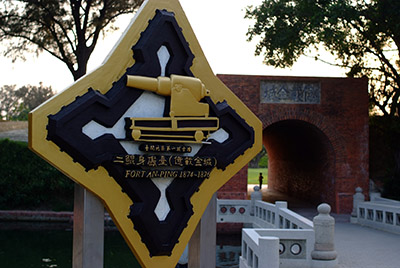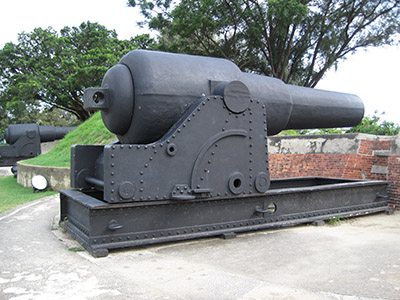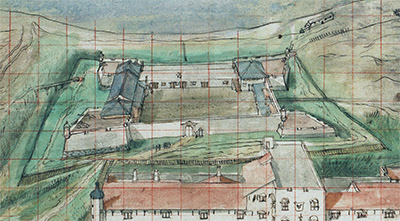 |
Eternal Golden Castle
Anping, Tainan, Taiwan
|
|
 |
Constructed: 1874 - 1876
Used by: China, Japan, Taiwan
Conflicts in which it participated:
Sino-French War,
First Sino-Japanese War
Also known as: Erkunshen Fortress, Fort An-Ping
|
The Eternal Golden Castle was the Qing Dynasty's first and only modern starfort, designed by a Frenchman and armed with British guns, but built by China. It defended the town of Anping twice from foreign invaders, with an impressive 50% success rate!
The Qing Dynasty, China's last imperial dynasty, ruled from 1644 to 1912. During this period the west became increasingly insistent that China really needed to willingly open itself up to exploitation, commercial and otherwise, but China did its best to keep the smelly westerners at arm's length. While mainland China at least held off wholesale colonization, Taiwan, isolated off of China's east coast, was less fortunate.
|
 |
|
|
The Dutch East India Company had moved in and built Fort Zeelandia on the island of Tayouan, just barely off of Taiwan's southwest coast, in 1624. The Spanish landed on and occupied northern Taiwan in 1626, where they remained until the Dutch pushed them into the sea in 1642. China's Ming Dynasty fell in 1644. In 1662 a merciless Mingian military leader named Koxinga (1624-1662) leapt over to Taiwan, captured Fort Zeelandia, booted the Dutch off the island and established the Kingdom of Tungning. This kingdom flourished for all of 20 years, and was the genesis of many coastal raids on mainland China. The Qing Dynasty finally tired of this nonsense and, in 1683, sent an armada that defeated Koxinga's grandson and formally annexed Taiwan. |
| Tayoun was once an island. The small lagoon separating it from mainland Taiwan silted up in the 19th century, making it part of the city of Tainan. Witness the Eternal Golden Castle to the left, and the remains of Fort Zeelandia to the upper left. |
 |
By the 18th century, Great Britain had finally managed to work a trade deal with China, through the one port they were allowed to visit, at Canton. In order to pay for the vast amounts of tea that Britain was importing from China, they cultivated opium from India and forced it on China as payment, despite the Qing government's increasingly frantic demands to stop this immediately!!! The huge influx of opium was predictably wreaking havoc on China's social structure, but why should that bother Great Britain, who was happy with its caffeinated beverage part of the deal?
China finally started seizing and destroying Britain's opium shipments in the 1830's, whereupon Queen Victoria (1819-1901) immediately apologized for the whole ridiculous situation, and Britain withdrew peacefully from the region forever. |
|
Just kidding! Queen Victoria may or may not have had any idea what was actually transpiring with this forced opium trade, but those who most certainly did know treated the whole thing as a huge national insult and sent in the gunboats. The Qing Dynasty's navy was humiliated by the modern Royal Navy in the First Opium War (1839-1842), and its land forces humbled by a combined British and French onslaught in the Second Opium War (1856-1860). At the end of all of this scuffling, ten new Chinese ports had been forcibly opened to European trade, millions had been paid to Britain and France in indemnities and Hong Kong had been surrendered to Great Britain.
|
The Qing Dynasty was struck with the realization that it needed to modernize its defenses if it ever hoped to exert its will against the powers of Europe.
In the 1870's, Qing official Shen Baozhen (1820-1879) headed a program to modernize both the Chinese Navy and its seacoast defenses. Interestingly, he did this with the assistance of various Frenchmen: Though China had recently been raped by France and Britain, France was (somewhat erroneously) considered the world's military authority through the 19th century.
|
 |
 This is the coolest sign ever in the entire history of signs. This is the coolest sign ever in the entire history of signs. |
|
A French engineer by the name of Bordeaux is credited with the design of the Eternal Golden Castle, which was built from 1874 to 1876. A four-bastioned, moated fort, entrance was gained over a drawbridge and through a tunnel. There was originally a pond in the fort's parade ground, which may have served some purpose other than just to provide pretty fishies to look at, but it's difficult to say with any degree of certainty.
The fort was armed with British Armstrong Guns, which at the time were at the cutting edge of modern artillery: Its armament is listed as five 80-ton guns, four 40-ton and four 20-pounders, the last of which assumedly refers to the weight of its shell as opposed to the weight of the piece. One hopes, because a cannon that weighs 20 pounds doesn't seem very threatening.
|
 One of the Eternal Golden Castle's remaining Armstrong Guns. Though these guns could be traversed 6° to the left or right without moving the carriage, one hopes that there were actual wheels involved in those mounts at some point. One of the Eternal Golden Castle's remaining Armstrong Guns. Though these guns could be traversed 6° to the left or right without moving the carriage, one hopes that there were actual wheels involved in those mounts at some point.
|
 |
Those Armstrong Guns were first fired in anger just 10 years after they were installed, at the folks who had designed the fort. The Sino-French War (1884-1885) was fought over control of Vietnam (known then as Tonkin), which at that point was part of the Qing Dynasty's domains, but upon which France had designs.
A French naval squadron blockaded the port at Tainan at the end of 1884, at least once poking into the harbor, but was dissuaded from further encroachment by the guns of the Eternal Golden Castle. Mission accomplished! European powers deflected!
While China was distracted with the French, however, a non-European power was conspiratorially rubbing its hands together.
|
|
A different fleet presented itself to the guns of the Eternal Golden Castle in 1894, that of Japan. The First Sino-Japanese War (1894-1895) was fought over control of Korea, which had been a vassal state of China's since the 17th century. The Japanese squadron was turned away from Tainan with the enthusiastic application of the Eternal Golden Castle's guns, but the rest of the war didn't go as well for the Qing Dynasty. Taiwan was ceded to Japan in 1895. The Eternal Golden Castle fell into disuse, and as a further insult Japan sold most of the fort's Armstrong Guns to help pay for its next war, the Russo-Japanese War (1904-1905).
The elements had their way with the Eternal Golden Castle until its centennial in 1976. The city of Tainan cleaned the fort up, painted its remaining guns an attractive black and sharpened its starfort corners. Today it is a major tourist attraction, although "probably the least interesting of the seven first-class historic sites in Tainan, it is still worth a visit if you have the time." If the other six aren't starforts, that would make it the most interesting attraction. One of the fort's guns is still serviceable, and is daily fired for the entertainment of all by period-dressed soldiers. And a visitor can steer a paddleboat around the fort's moat! How can any other attraction compete with that??!
|
Fort Zeelandia was built by the Dutch East India Company (VOC) from 1624 to 1634. This was the main Dutch stronghold in western Taiwan until 1662, when Koxinga showed up with 400 warships and 25,000 men and besieged the fort, which was defended by 2,000 Dutch soldiers. After nine months and the loss of 1,600 Dutch lives, those few that were left surrendered the fort. Depending on whose account one believes, the Dutch were either permitted to peaceably leave with their possessions, or were slaughtered and their wives given to Koxinga's officers as concubines.
|
 |
|
|
 A slightly more starrish-looking Fort Zeelandia, before it was overtaken by shrubbery A slightly more starrish-looking Fort Zeelandia, before it was overtaken by shrubbery
|
 |
Today, Fort Zeelandia is locally known as Anping Fort.
Ten thousand thanks to Taiwanese starfort appreciator Katy, who directed me to the Eternal Golden Castle! May all your castles be as golden as they are eternal!
|
|
|
|
|
|
|
 |




